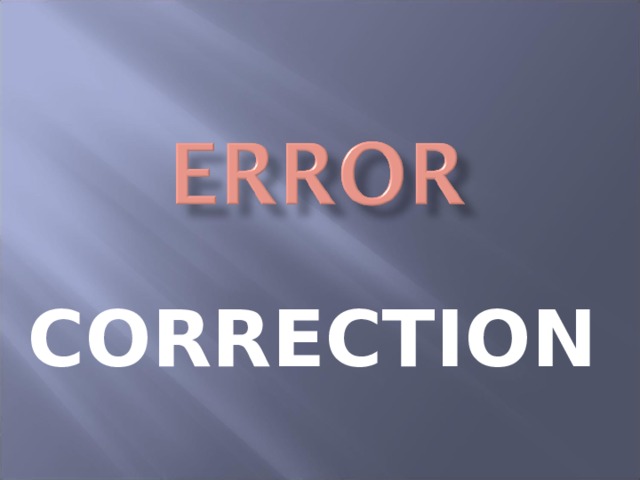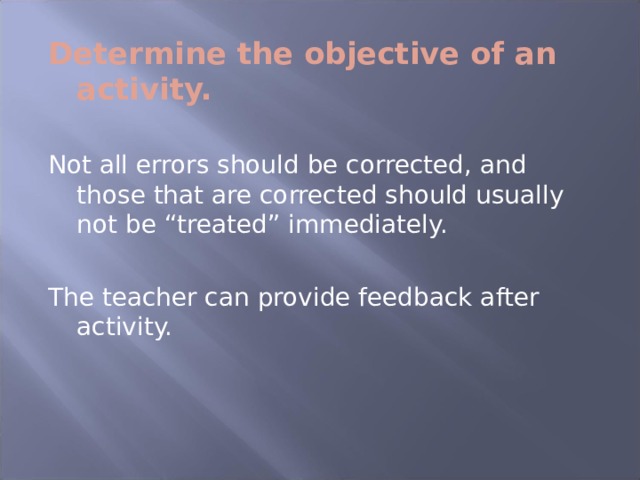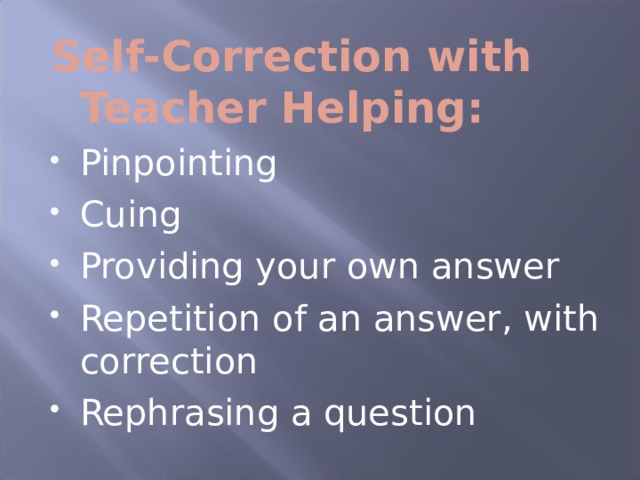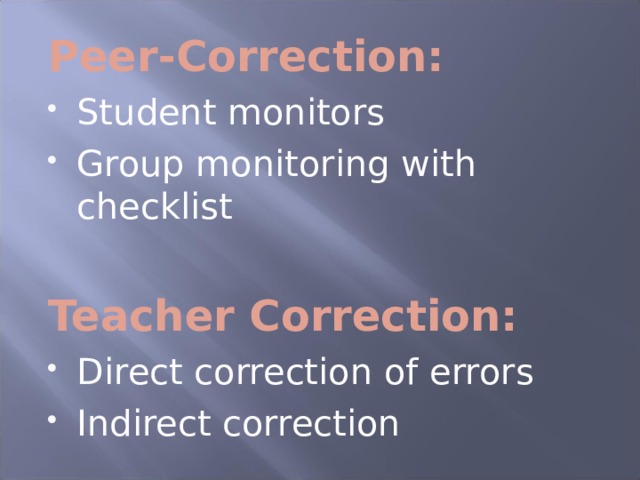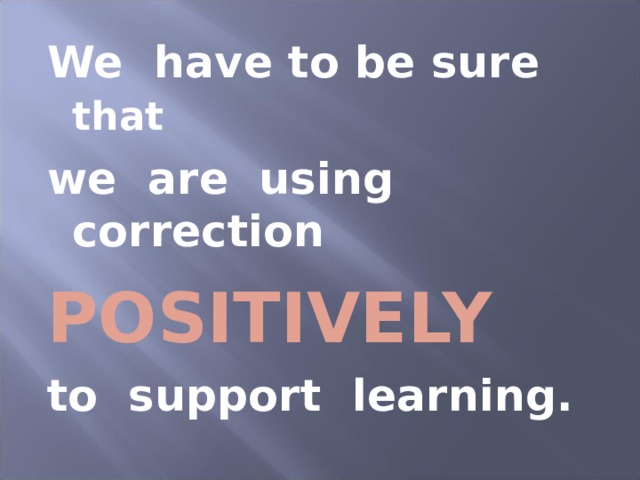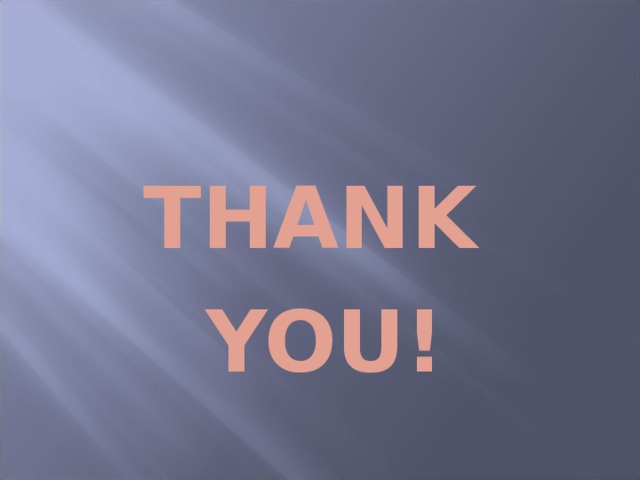Описание презентации по отдельным слайдам:
-
-
2 слайд
What is the role of error in language learning?
What decisions do teachers need to make regarding error correction?
What techniques can teachers use to correct student errors?Overview
-
3 слайд
Student errors are evidence that learning has not taken place.
Student errors are evidence that learning is taking place.
Which of these sentences do you most agree with? -
4 слайд
Gaps in knowledge
Interference (i.e. from L1)
Developmental errors
Forgetting
High demands (responding under time pressure)
Experimenting with language
Taking risks
Why do learners make errors? -
5 слайд
Aims when correcting:
To help students become more accurate in their language usage
To build learner confidence
To raise learner awareness
To acknowledge achievement & progress
To meet student/parent expectations
Why correct students? -
6 слайд
A student makes an error
Decide what kind of error has been made
Decide whether to deal with it
Decide when to deal with it
Decide who will correct
Decide on an appropriate technique
Teacher Decisions -
7 слайд
What kind of error?
Errors
Lexical
Grammatical
Discourse
Sociocultural
Phonological -
8 слайд
First decide if it is useful to correct the error
then
Correct now or later
When to correct? -
9 слайд
Who will correct?
-
10 слайд
Indicating/correcting errors
Tell the students (eg There’s an error in that sentence)
Facial expressions
Gestures
Finger correction (hold on to the ‘error’ finger – eg the third word)
Repeat sentences up to the error (eg They looked for a…?
Echo (with a change of intonation or stress)
Ask a question (eg Was this last week?)
Draw a timeline on the board
Write the problem sentence on the board (for discussion)
Use the phonemic chart (to point at incorrect phoneme)
How to correct? -
11 слайд
For an upcoming lesson
Plan an error correction strategy for each stage of the lesson, and indicate this in the lesson planSubmit the lesson plan for a brief discussion of why you chose these techniques prior to the lesson
Follow Up Task
Presentation on theme: «Error correction techniques for speaking 1 Error Correction Techniques.»— Presentation transcript:
1
Error correction techniques for speaking 1 Error Correction Techniques
2
Error correction techniques for speaking 2 Dealing with errors I never let my students make mistakes. If they say anything wrong, I stop them and make them say it correctly. I don’t want them to learn bad English from each other. I correct my students sometimes, but not all the time. If we’re practicing one particular language point, then I insist that they say it correctly. But if we’re doing a freer activity then I try not to correct too much. If I do correct students, I try to do it in an encouraging way. I try to correct errors as little as possible. I want my students to express themselves in English without worrying too much about making mistakes. Sometimes I notice points that everyone gets wrong, and deal with them later – but I never interrupt students to correct them. How do YOU deal with errors in your class? strictmediumeasy-going
3
Error correction techniques for speaking 3 Repetition drills Controlled dialogues Warm-ups Roleplays Speaking to a group Pairwork Picture descriptions Surveys
4
Error correction techniques for speaking 4 Learning correct structures Ability to communicate freely using structures ACCURACYFLUENCY Communicative language teaching “Learning about the language” “Learning to use the language”
5
Error correction techniques for speaking 5 Error correction Common mistakes – many people in the class are making same mistake Uncommon mistakes – only 1 or 2 people are making this mistake Mistakes using target language Mistakes using language studied in previous units Mistakes using more advanced language that Ss have not yet studied Big mistakes that caused a block in communication Which mistakes should the teacher correct? Which mistakes shouldn’t the teacher correct?
6
Error correction techniques for speaking 6 Error correction Indicating an error Without words! HAND FACE
7
Error correction techniques for speaking 7 Error correction My friend COME yesterday? Nearly – think about the tense Almost correct – there’s a problem with the 3 rd word My friend come yesterday Mmm, not come, but… With words! My friend came yesterday
8
Error correction techniques for speaking 8 Error correction My friend come yesterday 1. My 2. friend 3. 4. yesterday My friend came yesterday. With fingers!
9
Error correction techniques for speaking 9 Error correction Unnecessary wordMissing wordWrong word LinkingWord order I went early home
10
Error correction techniques for speaking 10 Common teacher concern
11
Error correction techniques for speaking 11 Error correction 1.Inform Ss you will deal with mistakes at the end of the activity, not during. 2.Go round listening to Ss, but don’t correct anyone! Instead, write down errors you hear on a piece of paper. Recommended correction procedure
12
Error correction techniques for speaking 12 Error correction Common mistakes – many people in the class are making same mistake Uncommon mistakes – only 1 or 2 people are making this mistake Mistakes using target language Mistakes using language studied in previous units Mistakes using more advanced language that Ss have not yet studied Big mistakes that caused a block in communication Make notes of the following types of mistakes :
13
Error correction techniques for speaking 13 Error correction DO : Listen discreetly Provide encouragement DON’T : Stand “over” Ss Interrupt unless “emergency”
14
Error correction techniques for speaking 14 Error correction 3. Write errors on board. Recommended correction procedure CHOICE 1 Write 5-8 sentences all containing errors that you heard. CHOICE 2 Write 4 “wrong” sentences & 4 “good” sentences you heard. Briefly comment on successful use of language & interesting ideas you heard
15
Error correction techniques for speaking 15 Error correction 4. Students work in pairs or groups to correct errors. Recommended correction procedure
16
Error correction techniques for speaking 16 Error correction 5. Select pairs / groups to tell you answers. Before confirming whether answer is correct or not, ask rest of class whether they agree or disagree. Get different opinions before revealing answer. Recommended correction procedure
17
Error correction techniques for speaking 17 Error correction 6. Keep this list of common mistakes for a future lesson. It could be reviewed later or included in a mid-term test! Recommended correction procedure
18
Error correction techniques for speaking 18 Summary 1.Inform Ss you will deal with mistakes at the end of the activity, not during. 2.Monitor Ss, write down errors you hear. 3.Write errors on the board. 4.Ss work in pairs / groups to correct errors. 5.Select pairs / groups to tell you answers & answer any further qs Ss may have. 6.Keep list for future test / revision.
Download

Skip this Video
Loading SlideShow in 5 Seconds..
ERROR CORRECTION PowerPoint Presentation
Download Presentation
ERROR CORRECTION
— — — — — — — — — — — — — — — — — — — — — — — — — — — E N D — — — — — — — — — — — — — — — — — — — — — — — — — — —
Presentation Transcript
-
ERROR CORRECTION
-
Error Correction • Two ways of handling error correction • The receiver can have the sender retransmit the entire data unit • The receiver can use an error-correcting code • To correct the error • Locate the invalid bit or bits
-
Error Correction r – redundancy bits required to correct a given number of data bits (m) — must be able to indicate at least m + r +1 states (no error, error in every bit position) — this is the required number of bits to cover all the possible single bit error r bits can indicate 2^r states Therefore, 2^r>= m + r +1
-
Hamming Code
-
Hamming Code
-
Hamming Code
-
Example of Hamming Code
-
Single-bit error
-
Error Detection
-
FEC – Forward Error Correction (From Tomasi) 2^n>= m + n +1 n = number of Hamming bits m = number of bits in the data character 1) For a 12-bit data stream of 1011 0001 0010, determine the number of Hamming bits required. 2) Arbitrarily place the Hamming bits into the data string. 3) Determine the condition of each Hamming bit. 4) Assume an arbitrary single-bit transmission error. 5) And prove that the Hamming code will detect the error.
-
FEC – Forward Error Correction (From Tomasi) 1) n = 4: 2^4>= 12 + 4 +1 16 >= 17 n = 5: 2^5>= 12 + 5 +1 32 >= 18 2) H101 H100 HH01 0H01 0 3) To determine the logic condition of Hamming bits, express all bit positions that contain a 1 as an n-bit binary number (ex. bit position 2 = 00010) and XOR them together. The result will be the Hamming code = 10110 1101 0100 1101 0001 0
-
FEC – Forward Error Correction (From Tomasi) 4) 1101 0100 1101 0001 0 Assume that an error occurs at bit position 3 1101 0100 1101 0011 0 5) At the receiver, determine the bit position in error, extract the Hamming bits and XOR them with the binary code for each data bit position that contain a 1. Hamming code = 10110 bit position 2 = 00010 bit position 3 = 00011 bit position 6 = 00110 bit position 12 = 01100 bit position 14 = 01110 bit position 16 = 10000 00011 Bit position 3 was received in error
-
EXERCISES 1. For each of the data unit of the following sizes, find the minimum number of redundancy bits needed to correct one single bit error: • 12, 16, 24, 64 2. Construct the hamming code for the bit sequence 10011101 3. A receiver receives the code 11001100111. When it uses the hamming encoding algorithm, the result is 0101. Which bit is in error? What is the correct code?
Feedback and Error Correction Global Standards for Education Office of Overseas Programming & Training Support (OPATS)
Learning Objectives Identify: (a) what good feedback should do for students, (b) what good feedback shouldn’t do to students, (c) techniques that provide supportive feedback. Analyze case studies of teacher-student interactions to determine when and how to give effective feedback. Practice using error correction techniques.
Let’s look at some feedback samples: What’s your impression here? T = Teacher J = Juan T: Juan, tell us about monarch butterflies. J: Butterflies yellow. Fly Mexico. It warm Mexico. Long time T: Good J: Me is right, Teacher? T: Yes, good job, Juan.
How do you react to this feedback? T = Teacher, S 1 = First Student S 2 = Second Student T. Hello everyone. Did anyone do anything interesting over the weekend? S 1: Teacher, I see a good movie. T: “I SAW a good movie. Often I SEE, yesterday I SAW. . I have SEEN See, Saw, Seen. Did you forget our unit on irregular verbs last week? Today I see, Yesterday I saw, I have seen. . . (teacher calls on a second student) Victor, did you see a movie this weekend? S 2: Yes, Teacher I saw a movie called “Moving Fast. ” T; Thank you Victor. I’m glad some students study.
GIVING FEEDBACK Giving Feedback
Feedback vs. Error Correction? Feedback is any advice or reaction that responds to communication (a student) has produced. Error correction is focused more on negative student production and aims to help the student repair such errors in the future.
What’s so tricky about feedback and error correction? Problem 1: Because we see giving feedback as a key teacher role, we tend to perceive our advice as affectively neutral: we aren’t criticizing— we’re just doing our job. However, learners will tend to perceive any feedback as a judgment on them. Problem 2: Even when we try to be neutral in feedback, our reactions and body language may often reveal when we feel students have “missed the mark. ” Problem 3: Failure to give correction when it is needed.
Group Work Let’s devise some principles for giving quality, meaningful feedback to students—in terms of our evaluations during whole group classroom participation. Think about What good feedback should do for the student What good feedback shouldn’t do TO the student Practices/techniques we can use to provide supportive feedback. .
Affective vs. Cognitive Feedback All feedback is both “affective” (about “feelings”) and cognitive (about “learning”). Some examples: Primarily Affective: Primarily Cognitive: “What kind of idiot are you? “Wow, I like what you’ve done! “I think you’ve made an error. ” “Yes, that’s correct. ” Note that both kinds of feedback can be positive, negative, or neutral.
Can You Think of an Example for Each Box? FEEDBACK VARIATIONS Positive Affective/Positive Cognitive Negative Affective/ Positive Cognitive Positive Affective/Negative Cognitive Negative Affective/Negative Cognitive
Softening Feedback Hedges (which precede a correction or modeling)— That’s pretty good… You’re on the right track… Thank you (for speaking)… That’s possible…
More Softeners Maybe… Okay… (drawn out with high-low-high intonation) That’s an interesting idea… I suppose that would work (you could say that)…a different way might be…. Uh-huh. Anyone else…. ? (more for content that form) That’s true. . .
Let’s Practice Giving Classroom Feedback Analyzing/Observing an ESL/EFL Lesson (Revised – 8/1/10) Ron Schwartz UMBC A. Analyzing/Observing an ESL/EFL Lesson You have been asked to observe a new ESL/EFL teacher. The teacher is highly motivated, shows great interest in the students, etc. . but lacks basic ESL/EFL skills. Below are descriptions of some of the activities that you observed during the class. Analyze each and make suggestions to the teacher for improvement. For each, you must work from theory to practice in your comments to the teacher. You must also give examples of what you think the teacher should do. Follow my example below. A help to do this test will be the handout “Classroom Interactions: Observation Form With Comments, Explanations, And Examples. ” Example: At the beginning of class, the students entered the class and sat down. The teacher immediately said the following. T: Open your books to page 7. Read the story. Some students opened their books. Others talked with each other while a few looked confused. The teacher sat at his desk going over some papers. Your comments to the teacher:
Error Correction
All students say that they want error correction— do you believe them? Importance of discussing feedback w/students Issues of peer correction Need to console learners for “stupid” mistakes.
Deciding When to Intervene – some questions to ask Is the error global or local? How does the error relate to the learner’s development? What is the type of activity engaged in? (fluency-accuracy) Is it an error of target language or incidental language? Is the error stigmatizing? Is correction likely to be disruptive?
If you do it, when to do it? Immediate Correction Delayed Correction
Correction Sheets—Again
How to do it? (1) Explicit Correction (it’s clear and straight forward): It’s “I’ve studied English for five years”, not “since five years. ” Repeat error as question (elicits, gives students a chance for redemption) “Since five years? Request Clarification (non-intrusive, elicits, gives students a chance for redemption) “What was that? ” “Could you repeat please? ”
How to do it? (2) Correct by stating (or asking a question) about the rule/principle involved: “Since” points to the beginning, “for” is about duration. Question eliciting self or peer correction (focuses on error, involves all learners): Is it correct to say “since” five years?
How to do it? (3) Modeling correct answer: also called “recasting. ” • less intrusive and confrontational than overt correction. • but learners may focus on the meaning of the utterance and notice the correction of form: • Student says, “I’ve studied English *since five years. The teacher provides a recast saying, “ I’ve studied English for five years, ” The student replies, “Yes, that’s right, ” thinking the teacher was unsure of what the student said. • This problem is particularly true of young learners who may simply be developmentally incapable of noticing subtle corrections of form.
Try the Error Correction Activity with Your Partner 1. Sao Paulo is the large city in the world. 2. Sonia can drive very good. 3. He has already starting 4. Mr. Wu cam to Singapore last year. 5. …
So, have we achieved our objectives? Being able to establish a classroom environment where feedback and error correction are effective, sensitive, and well received? Providing practice (through simulations) in giving effective feedback and useful learner-friendly error correction? Thanks!
1. Teaching teens course. Error correction.
Ведущая Аня Трофимова, автор и создатель паблика
EnglishMAnnia. Read books and teach.
20 мая 2017 г., Москва
2.
2012 год — РГУ имени С.А.Есенина по
специальности «Международные отношения»
2014 год — 3 модуля TKT (Teaching Knowledge
Test)
2014 год — экзамен CAE (grade A)
2016 год — курс Кэмбриджа CELTA (grade B)
2016 год — курс Кэмбриджа ICELT
2016 год — Диплом о профессиональной
переподготовке «Преподаватель английского
языка»
С 2012 года занимаюсь частной практикой, а с
2016 года работаю преподавателем в Высшей
школе лингвистики в Москве
С 2016 года веду паблик EnglishMAnnia. Read
books and teach
Замужем. Есть 2 кота
3. Мы обсудим следующие вопросы:
Нужно ли исправлять ошибки студентов?
Когда их исправлять?
Какие ошибки исправлять?
Как это делать?
4.
‘The main teacher’s
responsibility is
response-ability’
(Peter Wilberg)
5. To correct or not to correct?
Какую ошибку совершил студент?
Нужно ли её исправлять?
Когда её исправлять?
Кто будет её исправлять?
Как её исправить?
Какой сегодня день? Который час? Какая погода?
6. Showing incorrectness during accuracy activities
S: I’ve seen my brother
yesterday.
T: Oh, where did you see
him?
S: I saw him in the
cinema.
T: What film did he
watch?…
S: I growed
up in
Canada.
T: GROWED?
S: I growed up
in Canada.
T:Oh, you grew
up in Canada,
didn’t you?
Again?
Tense?
7. Showing incorrectness during accuracy activities
Ok, is the
action in the
past? Is it
finished? So…
Ok, is the
action in the
past? Is it
finished? So…
8. Correction and accuracy. Self-correction
Преимущества
Вовлеченность студентов
Развитие
самостоятельности
Уменьшение TTT (Teacher
talking Time)
9. Peer correction
Многие подростки уязвимыми и не хотят выглядеть слабыми перед другими.
Они могут чувствовать себя некомфортно, критикуя или будучи критикуемыми
другими, в том числе и своими друзьями
Вызываться волонтерами исправить ту или иную ошибку могут все время одни и тебе
люди
Способствует развитию атмосферы взаимопомощи в классе
Вовлеченность студентов
Помогает нам много узнать о наших студентах
10. The last resort Teacher correction
Do you need to teach it
Overstressing the correct
again but in a different way?
part, e.g. invenTED
11. О том, как НЕ надо
First input, then output!
12.
13. Lets’ have some practice!
1. I am agree with you.
2. I’ve been to the desert yesterday
3. You are a doctor?
14. Correction and fluency
Do you
need to?
How can I deal
with mistakes
made during
freer activities?
15. Spoken English
1. Teacher: Why are you so late?
Student: I’m sorry, my mother is take to hospital
Teacher: No, not ‘is take’, she ‘has been taken’ to hospital.
2. Teacher: Why are you so late?
Student: I’m sorry, my mother has been taken to hospital
Teacher: Good!
Очень часто преподаватели
реагируют не на то, ЧТО
студент сказал, а КАК он это
сказал
16.
We need to respond to the
CONTENT, and not just to
the language form!
17. Correction and fluency
In other situations
Gentle correction
Delayed error
correction
18. Delayed error correction
A teacher is not
A teacher is
Monitoring
Making notes of students’
mistakes
Or
Recording students
19. Let’s have some practice! What is the most important mistake in these conversations?
20. The answers:
The most important
sort of mistake is a
mistake that leads
to
misunderstanding
When we talk to
people, being
polite is more
important than
being linguistically
correct
21.
22. Written English
A: When I saw him the other day, well, it was yesterday,
actually, he was looking down
B: What, you mean, at the pavement?
A: (shakes head) No, I mean, depressed – he was looking
depressed, as if he was still thinking about Lucy.
B: Well, he always does.
A: Does what?
B: Look depressed. He did even before he met Lucy.
23.
Hi, Peter!
How are you? Hope you are well! What about your car? Do
you repair it? How’s your dog?
I’m going to MGU next week, on maths college. Maybe I’ll
go to another universities also. After I’m planning go to
London to study English. I passed all my exams recently.
Also I’m going to buy a new car! It’s will be Moserati
Vulcano! Do you know it?…..
24.
The point of giving
feedback on writing is
for students to write
better!
25.
Осталось 6
слайдов!
26. The red pen syndrome
27. Используйте Correction code
? = Confusing, I don’t WW = Wrong Word
understand what it
WO = Word Order
means
P = Punctuation
^ = Missing word
Sp = Spelling
( ) = Not necessary
F/I = Too formal/
T = Tense
informal
Gr = Grammar
28. Why is ‘Good’ bad?
29. The praise sandwich
30. Как избежать ‘the but part’?
Вместо
But
However
Используйте
In order to make your
writing even more
effective
To make your letter even
better
31.
There is no point
in feedback if it
doesn’t lead to
something!
Error Correction in a Communicative Class — PowerPoint PPT Presentation
Description:
Error Correction in a Communicative Class Katherine C. FitzSimons English Language Fellow Guayaquil, Ecuador 2008-2009 09 4664 358 celular ukraitie_at_yahoo.com – PowerPoint PPT presentation
Number of Views:152
Avg rating:3.0/5.0
less
Transcript and Presenter’s Notes
Title: Error Correction in a Communicative Class
1
Error Correction in a Communicative Class
- Katherine C. FitzSimons
- English Language Fellow
- Guayaquil, Ecuador 2008-2009
- 09 4664 358 celular
- ukraitie_at_yahoo.com
2
Do you agree with this statement?
- We learn by making mistakes.
3
Creating an Environment in Which Mistakes are OK
- If you believe that we learn by making mistakes
then it is critical to create a classroom
environment in which mistakes are OK.
4
Error Correction
- Errors are natural and normal.
- Errors should not make a student feel bad, sad,
nervous, or stupid. - Before students can be ready for an exam they
need to understand their errors and how to
correct them. - However, not all errors need to be corrected for
successful real world communication.
5
Warm-upWhat kind of corrector are you?
- In groups, read dialogues 1-6 from the handout
Sample Correction Techniques. - Think about who corrected the students in the
dialogues, when, where and how they were
corrected.
6
What techniques did the teacher use in dialogues
1-6?
- Says what was wrong
- Asks students to repeat correct answer
- Uses gestures or facial expressions to indicate
wrong answer - Asks for the rule
- Provides correct language naturally in passing
- Gets answer from another student
- Gets answer from same student
- Says answer was wrong
- Provides model of correct answer
- Indicates error with rising intonation
7
Your Opinion
- Why do students make errors?
8
Why do students make errors?
- They are practicing a new language.
- They are nervous or forget.
- Teachers focus too much on reading and writing so
speaking and listening are difficult. - There are differences between the mother tongue
and the new language. - No one speaks perfectly.
9
Your Opinion
- Should errors be corrected?
10
Why correct errors?
- Students want to be understood.
- Students expect to be corrected by the teacher.
- Students want to improve and feel confident.
- Students dont know they are making mistakes.
- Students want to complete tasks successfully.
11
Your Opinion
- Which errors require correction?
12
Which errors should be corrected?
- Errors that detract from successful completion of
a task. - Errors that affect students ability to be
understood. - Repeated errors.
- Shared errors.
- NOTE Mistakes are different from errors because
they are not repeated often. The student knows
the rule but simply forgets it temporarily.
13
Your Opinion
- When should error correction happen?
14
When to correct errors?
- ImmediateAt the exact moment of production
- DelayedNote the error and correct it later (at
the end of the students speech, task, lesson,
day) - NeverNo correction
15
Activity When to correct
- Read the handout Correction Techniques
Summary. - Discuss with a partner WHEN to correct the
student in each situation and put an X in the box
Immediate, Delayed, or No Correction.
16
Your Opinion
- Where can we correct errors?
17
When to correct errors?
- In PublicMake one students error a lesson for
all - IndividuallyWorking only with the student who
made the error
18
Activity Where to correct
- Read the handout Correction Techniques Summary
again. - Discuss with a partner WHERE to correct the
student in each situation and put an X in the box
for Individual or Public.
19
More information about when to correct errors
- Error correction depends on many factors
including - Learner sensitivity
- Learner situation
- Learning purpose (fluency or accuracy)
- Task type (reading, writing, speaking, listening,
individual, group work)
20
Your Opinion
- Who can correct errors?
21
Who can correct errors?
- Self-correctionThe student corrects himself
- Peer correctionThe group helps to correct
another student - Teacher correctionThe teacher demonstrates the
correct form - Which type is the best? Why?
22
Activity Who can correct
- Read the handout Correction Techniques Summary
once more. - Discuss with a partner WHO can correct the
student in each situation and put an X in the box
for Self-correction, Peer correction, or Teacher
correction.
23
Your Opinion
- How should corrective feedback be carried out?
24
How should errors be corrected?
- For repeated or shared errors, the teacher needs
to provide a model of the correct language. - Grammar errors may require a review of rules and
extra practice. - Pronunciation errors may require more minimal
pair or sentence stress practice. - All error correction should be done with
sensitivity to avoid embarrassment and fear.
25
Role of the Teacher in Communicative Error
Correction
- The teacher can be
- Reference Book
- Partner
- Helper
- Enemy
- Authority Figure
- What do these terms mean?
- Which one is best? Why?
26
Activity The Teachers Role
- Read the handout Teachers Role.
- Work in groups. Tell each other which role you
think the teacher plays in each situation. - Try to predict the students reaction to each
situation.
27
In conclusion
- Several studies report that indirect feedback
leads to either equal or greater levels of
accuracy than direct feedback over time. - (Ferris et al., 2000 Ferris Helt, 2000
Frantzen, 1995 Lalande, 1982 Lee, 1997 Robb et
al., 1986).
28
THANK YOU!!!
- Katherine C. FitzSimons
- English Language Fellow
- Fundación Ecuador-Aprendamos
- ukraitie_at_yahoo.com
- 09 4664358 celular
Слайд 2
What is the role of error in language learning?
What decisions do
teachers need to make regarding error correction?
What techniques can teachers use to correct student errors?
Overview
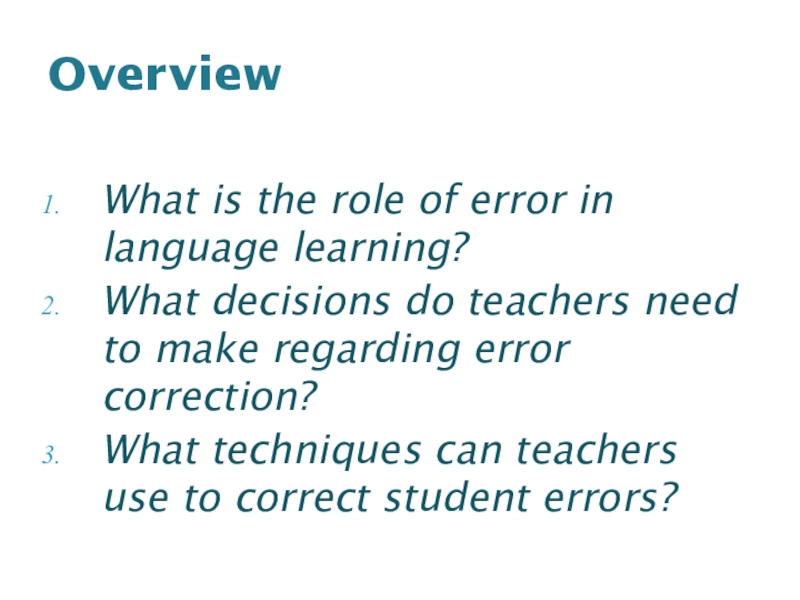
Слайд 3Student errors are evidence that learning has not taken place.
Student errors
are evidence that learning is taking place.
Which of these sentences do you most agree with?
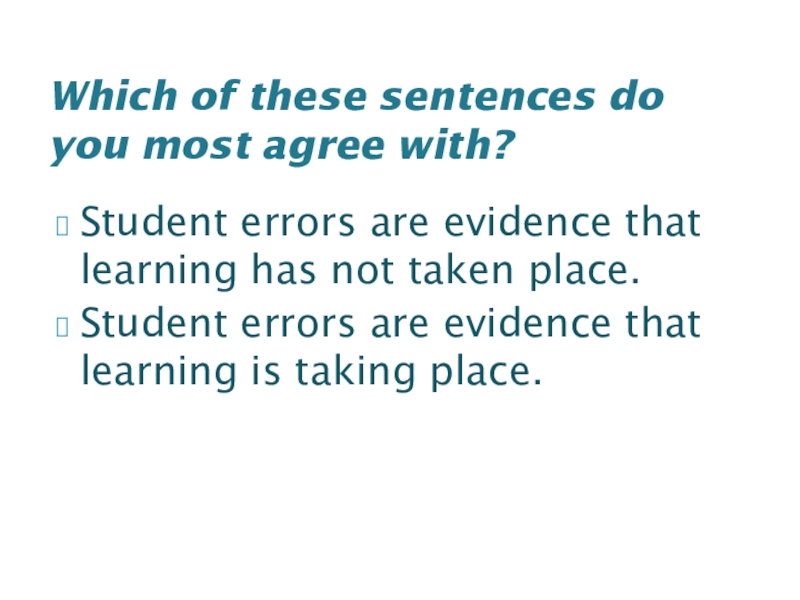
Слайд 4Gaps in knowledge
Interference (i.e. from L1)
Developmental errors
Forgetting
High demands (responding under time
pressure)
Experimenting with language
Taking risks
Why do learners make errors?
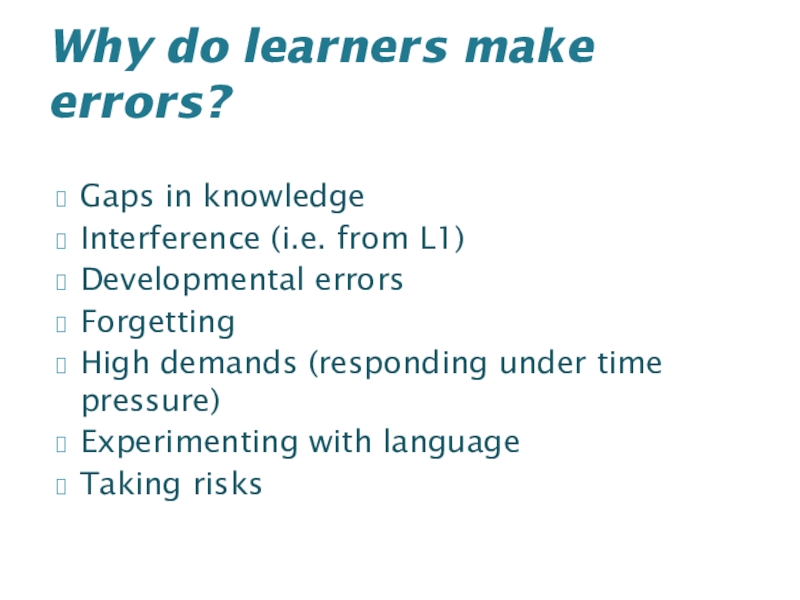
Слайд 5Aims when correcting:
To help students become more accurate in their language
usage
To build learner confidence
To raise learner awareness
To acknowledge achievement & progress
To meet student/parent expectations
Why correct students?
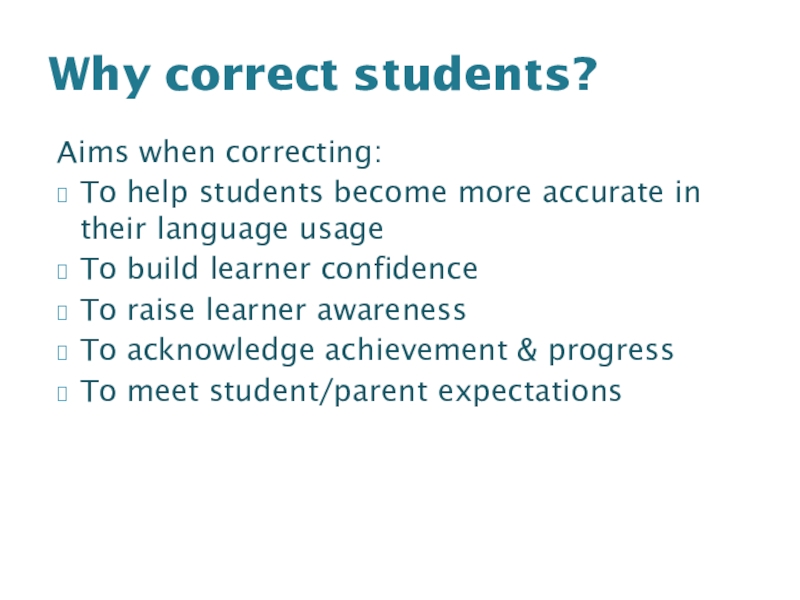
Слайд 6A student makes an error
Decide what kind of error has been
made
Decide whether to deal with it
Decide when to deal with it
Decide who will correct
Decide on an appropriate technique
Teacher Decisions
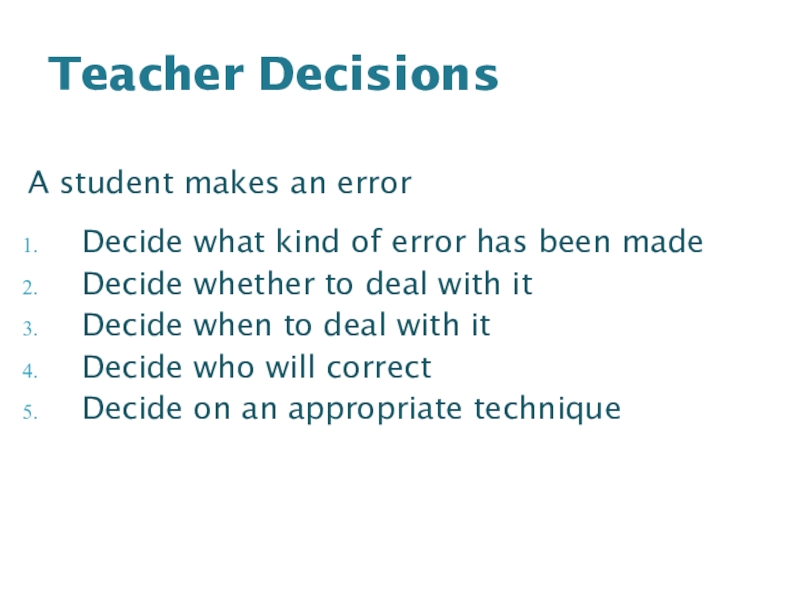
Слайд 7What kind of error?
Errors
Lexical
Grammatical
Discourse
Sociocultural
Phonological
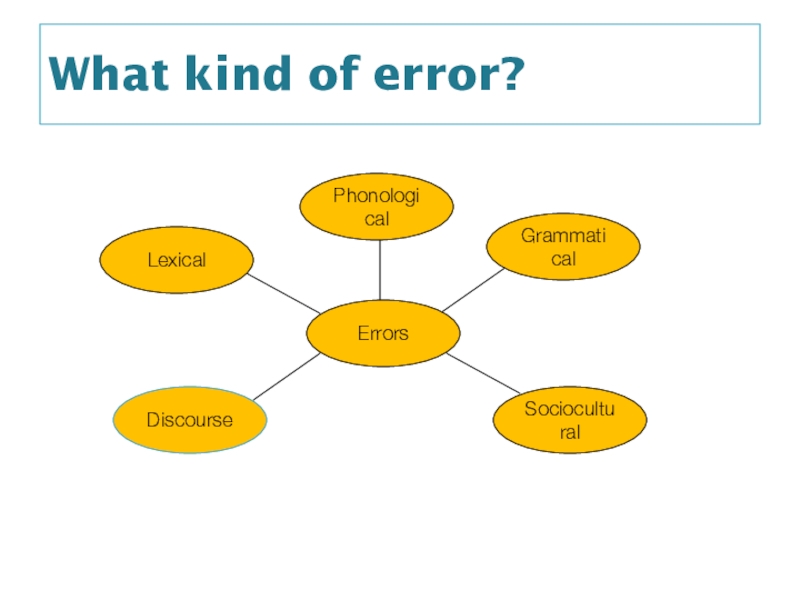
Слайд 8First decide if it is useful to correct the error
then
Correct now
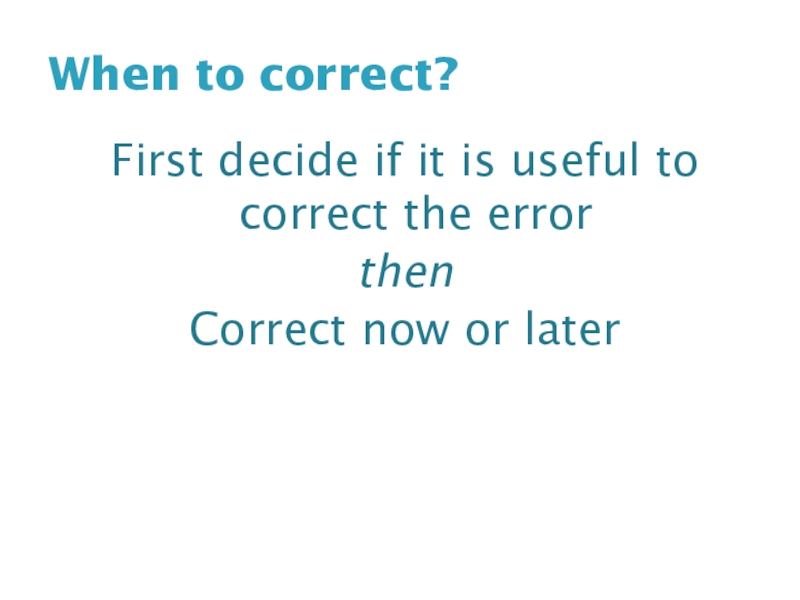
Слайд 10Indicating/correcting errors
Tell the students (eg There’s an error in that sentence)
Facial
expressions
Gestures
Finger correction (hold on to the ‘error’ finger – eg the third word)
Repeat sentences up to the error (eg They looked for a…?
Echo (with a change of intonation or stress)
Ask a question (eg Was this last week?)
Draw a timeline on the board
Write the problem sentence on the board (for discussion)
Use the phonemic chart (to point at incorrect phoneme)
How to correct?
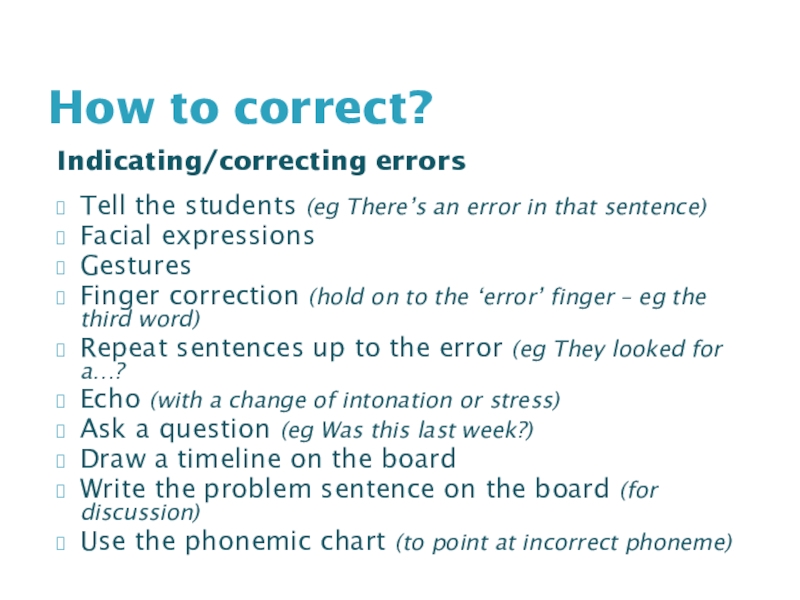
Слайд 11For an upcoming lesson
Plan an error correction strategy for each stage
of the lesson, and indicate this in the lesson plan
Submit the lesson plan for a brief discussion of why you chose these techniques prior to the lesson
Follow Up Task
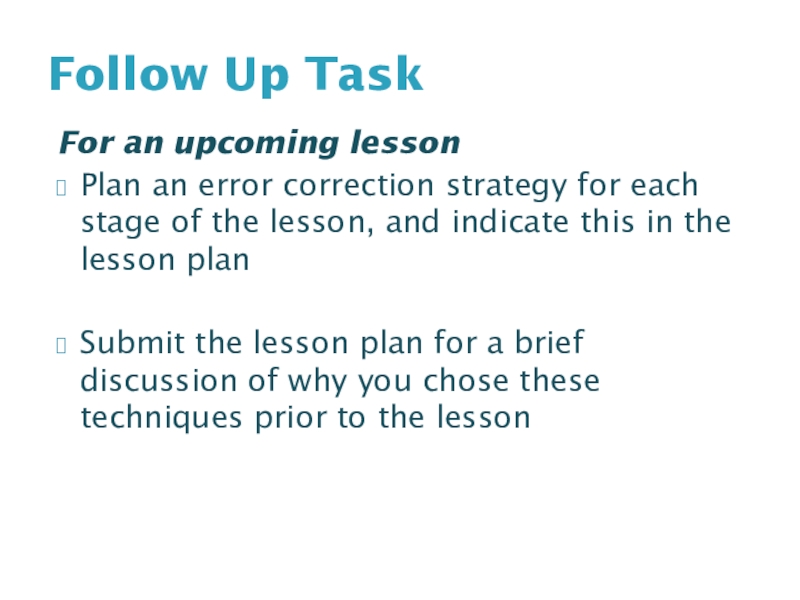
Презентация на тему: » Chapter 9 Error Detection and Correction Types of Errors Detection Correction WCB/McGraw-Hill The McGraw-Hill Companies, Inc., 1998.» — Транскрипт:
1
Chapter 9 Error Detection and Correction Types of Errors Detection Correction WCB/McGraw-Hill The McGraw-Hill Companies, Inc., 1998
2
Figure 9-1 WCB/McGraw-Hill The McGraw-Hill Companies, Inc., 1998
3
Single-bit error Figure 9-2 WCB/McGraw-Hill The McGraw-Hill Companies, Inc., 1998
4
Multiple-bit error Figure 9-3 WCB/McGraw-Hill The McGraw-Hill Companies, Inc., 1998
5
Burst error Figure 9-4 WCB/McGraw-Hill The McGraw-Hill Companies, Inc., 1998
6
Redundancy Figure 9-5 WCB/McGraw-Hill The McGraw-Hill Companies, Inc., 1998
7
Figure 9-6 WCB/McGraw-Hill The McGraw-Hill Companies, Inc., 1998
8
VRC Figure 9-7 WCB/McGraw-Hill The McGraw-Hill Companies, Inc., 1998
9
LRC Figure 9-8 WCB/McGraw-Hill The McGraw-Hill Companies, Inc., 1998
10
VRC and LRC Figure 9-9 WCB/McGraw-Hill The McGraw-Hill Companies, Inc., 1998
CORRECTION
- To help teachers to construct their own rationale for error correction
- To give practical suggestions for responding to students’ errors
- To encourage teachers to use error correction strategies in the classroom
PWAT:
- To distinguish between different types of errors
- To use error correction strategues in their teaching
- Global error
- Local error (a mistake)
- A slip
Global errors -hinder communication; they prevent from comprehending some aspect of the message.
Local errors — affect a single element of a sentence, do not prevent a message from being heard; context provides keys to meaning.
A Slip — a small mistake made by being careless or not paying attention.
- Global errors -hinder communication; they prevent from comprehending some aspect of the message. Local errors — affect a single element of a sentence, do not prevent a message from being heard; context provides keys to meaning. A Slip — a small mistake made by being careless or not paying attention.
HOW DO WE DEAL WITH STUDENTS’ ERRORS?
- WHAT should we correct?
- WHEN should we correct?
- HOW should we correct?
- GLOBAL ERRORS need to be corrected in some way since the message may otherwise remain unclear.
- LOCAL ERRORS (mistakes) need not to be corrected since the message is clear and correction might interrupt the learner in the flow of productive communication.
- A SLIP is what a learner can self correct and needs not to be corrected.
Determine the objective of an activity.
If the objective is to develop accuracy, correction is necessary.
If the objective is to develop fluency, correction may not be necessary or desirable.
- Immediately?
- After a phrase? A sentence?
- At the end of the “idea block”?
- At the end of the lesson?
- Every 5-7 minutes?
- After the activity?
Determine the objective of an activity.
Not all errors should be corrected, and those that are corrected should usually not be “treated” immediately.
The teacher can provide feedback after activity.
ERROR
CORRECTION
STRATEGUES FOR
THE CLASSROOM.
Self-Correction with Teacher Helping:
- Pinpointing
- Cuing
- Providing your own answer
- Repetition of an answer, with correction
- Rephrasing a question
Peer-Correction:
- Student monitors
- Group monitoring with checklist
Teacher Correction:
- Direct correction of errors
- Indirect correction
We have to be sure that
we are using correction
POSITIVELY
to support learning.
THANK
YOU!







































